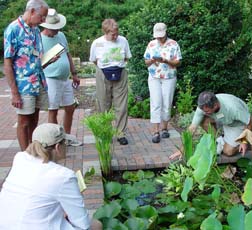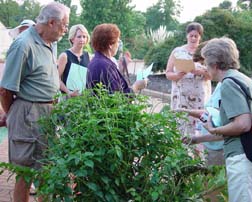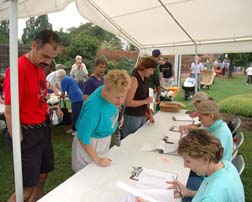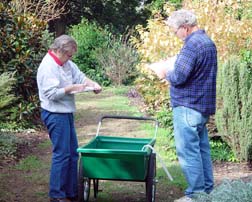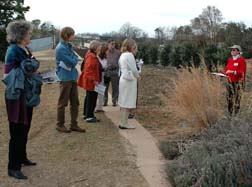Friends of the Arboretum Newsletter
Volume 9, Number 1
 |
 |
 |
 |
Director's Letter
Moving on
By Bob Lyons, Ph.D., Former Director
As I turned in this, my final contribution to this newsletter, I told Chris Glenn blame it on me if this issue goes to press late. You see, writing this letter has always been something that I enjoyed, but also something that I can't just sit down and do on cue. As any writer will probably agree, putting pen to paper (or fingers to keys in today's world) to produce something worthwhile takes more than allotting a couple of hours in your daily schedule. That may work for checking off a "to do" list, but it is hardly effective for penning the Director's Letter, and my final one at that! Being in the right frame of mind can make all the difference in the world and being caught up with all the new preparations related to my departure hampered the onset of that "right frame of mind," I'm sure. In any event, my apologies for any publication delay I may have caused.
It would certainly be appropriate and perhaps expected for any outgoing director to recant a litany of changes, accomplishments, and significant events that marked their tenure. And, for sure, I'll get into that in a minute, but I'd rather start with the last days first. To put it very simply, I was absolutely floored by the outpouring of appreciation I experienced during my last few months at the Arboretum. Your e-mails, cards, special mementos, and personal visits meant very much to me, as did your understanding of my decision to test out the new waters of a new position. Most organized "farewells" took the form of a "roast" and I was often surprised by what surfaced...apparently my mind did a fairly good job of selective recall as I had blocked out many of the incidents revived by the going-away parties! Many thanks to my staff whose well-organized gathering at Nancy Doubrava's was both hilarious and poignant. I have recounted their talents oftentimes in my past comments, but they truly are the best and their special gift of the signed quartet of photos representing the seasons in the JCRA will be long cherished.
Many thanks to our volunteers, too. They have always been known for their tireless and significant contributions to the general well-being of the JCRA. I have made some solid friends amidst this group, for sure, and am especially thankful for the December party at Amelia Lane's home. It was always a personal highlight to host the holiday open house for volunteers at my home, but my impending move just wouldn't permit that. Having a chance to say some last minute "good byes" when Amelia took on that event was very special...and that signed book and beautiful blue ceramic container from the volunteers will remind me of you all for years to come! Some people may not realize that I, too, oversaw a volunteer group, a way to maintain my own sanity by keeping my hands busy in the garden. These folks were very allegiant and became known as the Monday night/Saturday morning volunteers and I could convene them with a simple e-mail call to arms. We did everything from work in the annual trials, prune climbing roses, and weeding, weeding, weeding...and, man, was their assistance valuable! I was also very saddened when our group lost one of its own regulars, Lou Fitzgerald, just weeks before my departure. I was so thankful, however, that he and I worked side by side about a week before his heart got the best of him and we were able to talk about my new position. He'll be missed but also fondly remembered, especially amongst that team of volunteers.
To the entire department, college, green industry members, and myriad of other well-wishers, your farewell reception will never be forgotten! I was both shocked and delighted to have the opportunity to see so many of you in one place, at one time, and I'm still trying to separate fact from fiction from all the stories...but I guess it really doesn't matter! That incredible indoor greenhouse (which I like to call my personal Wardian Case) was a superb choice for a farewell gift and I'll remember you all for a long time to come whenever I view it...wherever I eventually call home. Seeing all of you simply reminded me of the countless new friends I've made in North Carolina in a relatively short time frame; and for someone like me who landed here six years ago with few prior acquaintances, I couldn't be happier about that. What a flashback it has been to recall even nanoseconds of my classes, talks and presentations, committee meetings, outreach events, and just plain friendly and professional interactions with so many of you. Special appreciation to our own JCRA Board of Advisors who seemed to kick off all the farewell festivities by hosting a surprise reception for me at the final board meeting of 2004. I will certainly regret not having the opportunity to work with the newest members of the board and I'll miss my associations with current board members. We have done plenty together and all for the betterment of the JCRA. The ceramic vase is great and that poster depicting a hapless JCRA Director crossing the street is just too clever! In the last month on the job, it took on a special life of its own as it became the place to pen one's autograph from all reception attendees and just about anyone else who walked into my office prior to my departure...it is now literally covered with signatures and for that I'm especially grateful.
Of course, I could go on forever on the subject of farewells, but I really did want to summarize just a few of the highlights of my tenure here at NC State and the JC Raulston Arboretum. I was not always the best person to heed my own advice because if I did, I would have reflected upon our accomplishments more often. I'm pleased that we stuck to and strengthened our mission here at the JCRA. We continued to amass, teach about, and expand the outside world's view of landscape plants. Our collections were unsurpassed and unparalleled, and that sentiment was not only echoed by ourselves. We achieved closure on the planned capital improvements through the opening of the Ruby C. McSwain Education Center and associated buildings. Our staff grew along with our internal budgets, we enhanced student participation in the JCRA via formal educational experiences and new summer internships, our plants and programs were better interpreted in an active and passive sense, we traveled near and far and took members along with us, and we improved the rewards for volunteer hours accumulated. The number of JCRA vehicles increased, we renovated and improved numerous garden spaces, most notably the enormous Perennial Border, and sponsored notable speakers. By acquiring partnerships, we constructed a new Lath House, produced a commemorative alumni calendar, and contributed to an award-winning Extension publication in Successful Gardener. More and more plant groups became integrated into our evaluation efforts, and we hosted and were a part of industry field days throughout the year. Our Galas became increasingly more successful, financially and otherwise, and we initiated an overall endowment for the JCRA that now totals over $35,000.00. We embraced new forms and vehicles of information technology, resulting in Web access to our newsletter, a hugely successful listserv and monthly electronic update, award-winning publications produced by sophisticated software mastered by talented staff, and acquired better and better computer hardware...and this just scratches the surface.
However, in the interest of space and with the knowledge that I could write forever as easily as I can speak without using a period, I'll sign off as your director feeling very good about our accomplishments, our dedicated membership, the state of our collections, and what the future has in store for the JCRA and any new director. I leave you not with "good bye," but rather with "see you later," as I hope you will come and visit me at the University of Delaware and Longwood Gardens...just not all at once, please, and remember to look both ways before crossing the street!
Newsletter Dedication
This newsletter is dedicated to Bob Lyons and Todd Lasseigne in appreciation for their years of service and support of the JC Raulston Arboretum.
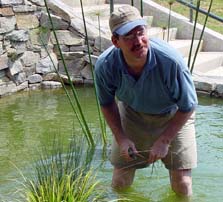 |
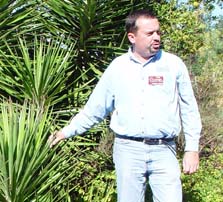 |
Welcome
New Staff
 M.A.
"Kim" Powell, Interim Director and Professor, NC State
M.A.
"Kim" Powell, Interim Director and Professor, NC State
M.L.A. NC State University, 1974
We are excited to welcome Kim Powell as interim director of the JC Raulston
Arboretum. He has been a faculty member of the Department of Horticultural
Science since 1978. His Extension responsibilities include landscape design,
landscape contracting, and landscape management.
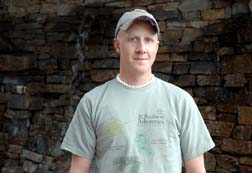 James
Lail, Horticultural Assistant
James
Lail, Horticultural Assistant
A.A.S. CALS Agricultural Institute, NC State, 2004
James Lail was our summer 2004 Raleigh Garden Club/Friends of the JCRA Intern.
He joined the Arboretum staff in January shortly after receiving his Associate's
degree, filling the position previously held by Anne Calta and more recently
by Peter Conden.
Horticulture
Walk and Talk at JC Raulston Arboretum with Michael Dirr
By Vivian Finkelstein, JCRA Volunteer, and Nancy Doubrava, Interpretive Specialist
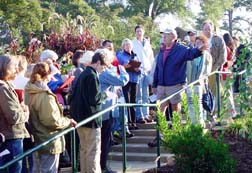 Imagine
touring the JC Raulston Arboretum alongside world-renowned plantsman and author
of the standard reference text on woody plants, Michael Dirr,
Ph.D (below). Last October, two very enthusiastic groups of Arboretum symposium
participants had this opportunity - one unsurpassed for any plant geek. Currently
residing in our region, Mike often visits the JC Raulston Arboretum, whose plants
have become familiar to him. A former professor at University of Georgia at
Athens, he is a master teacher, superbly knowledgeable plantsman, and an inspiration
for new talent. He showed what he felt were the best of the best plants, while
praising many fine plantsmen along the way. These are a few of the highlights
from his tour.
Imagine
touring the JC Raulston Arboretum alongside world-renowned plantsman and author
of the standard reference text on woody plants, Michael Dirr,
Ph.D (below). Last October, two very enthusiastic groups of Arboretum symposium
participants had this opportunity - one unsurpassed for any plant geek. Currently
residing in our region, Mike often visits the JC Raulston Arboretum, whose plants
have become familiar to him. A former professor at University of Georgia at
Athens, he is a master teacher, superbly knowledgeable plantsman, and an inspiration
for new talent. He showed what he felt were the best of the best plants, while
praising many fine plantsmen along the way. These are a few of the highlights
from his tour.
Liriodendron tulipifera 'Ardis'
Mike began the tour at a relatively small, but very fine tree, the littleleaf
tuliptree (Liriodendron tulipifera 'Ardis') growing near the Arboretum's
parking lot. He pointed out that 'Ardis' is small in both leaf size and stature,
a compact version of standard species tuliptree - a behemoth. An introduction
by J.C. McDaniel, Ph.D., University of Illinois, it is an excellent choice
for today's smaller landscapes.
Nyssa sylvatica 'Wildfire'
The next stop was at a beautiful black gum tree, Nyssa sylvatica 'Wildfire' growing near the parking circle. Living up to its name, it has red
new growth, outstanding fall color, red veins, and a red petiole. Mike prefers
this cultivar to the one bearing his name, Nyssa sylvatica 'Dirr', a
favorite at the Arboretum for its outstanding fall color. The cultivar 'Dirr'
was a clone of a black gum J. C. Raulston, Ph.D., selected in Athens,
Georgia, for its brilliant Chinese lacquer red fall color. Mike had sent him
cuttings to propagate at the Arboretum. 'Wildfire' appears to be less susceptible
to leaf spot. 'Dirr' is located near the JCRA Book and Gift Shop.
Liquidambar styraciflua 'Slender Silhouette'
Not far away was the fastigiate sweetgum (Liquidambar styraciflua 'Slender
Silhouette'), growing near the brick parking circle. For a narrow specimen
tree, Mike prefers it to the upright European hornbeam (Carpinus betulus 'Fastigiata'), which, although slender in youth, eventually opens up with age.
We can thank the internationally known plantsman, Don Shadow (Shadow
Nursery, Inc., Winchester, Tennessee), for this plant introduction.
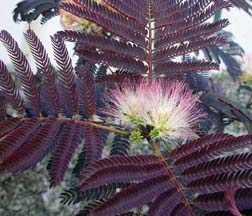 Albizia
julibrissin 'Summer Chocolate' PP13,822
Albizia
julibrissin 'Summer Chocolate' PP13,822
The group gathered closely around Mike to see another eagerly anticipated plant
introduction, the purple-leaf mimosa (Albizia julibrissin 'Summer Chocolate').
He described how the new spring growth emerges with bronzy purple leaves, and
then this fantastic leaf color turns an even deeper purple in the summer heat.
Purple leaves all summer! Discovered by the Japanese nurseryman, Masato
Yokoi, the Arboretum's specimen came as a gift to the Arboretum from Mike
Ishii (Ishii Plants, Saitama City, Japan). Always the teacher, he showed
us how the mimosa seed looks like a tick. The Arboretum's specimen of 'Summer
Chocolate' is growing by the steps between the Ruby C. McSwain Education Center
and the JCRA Book and Gift Shop.
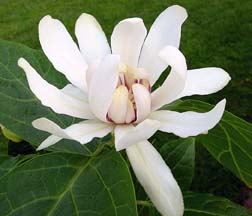 ×Sinocalycalycanthus 'Venus'
×Sinocalycalycanthus 'Venus'
Growing unassumingly at the south edge of the brick parking circle is another
new introduction, Venus sweetshrub (×Sinocalycalycanthus 'Venus'). 'Venus'
has lovely star magnolia-like white flowers with an alluring fragrance. It
has proven to be heat tolerant for southern gardens. This white-flowered shrub
is a descendant of the hybrid Raulston allspice (×Sinocalycalycanthus raulstonii 'Hartlage Wine'), which was then crossed with related Calycanthus species.
'Venus' resulted from breeding work done by NC State professor Tom Ranney,
Ph.D., (NC State Mountain Horticultural Crops Research and Extension Center,
Fletcher, North Carolina). "He's the best scientific breeder in the country,"
said Mike. "Tom is reaching for the stars with his program and succeeding."
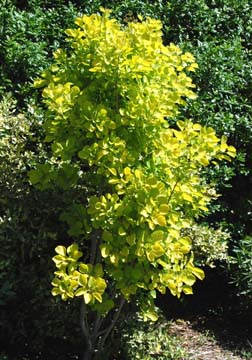 Cotinus
coggygria Golden SpiritT PP13,082
Cotinus
coggygria Golden SpiritT PP13,082
The golden smokebush (Cotinus coggygria Golden SpiritT) won high praise
from Mike. The foliage emerges gold-yellow and retains this stunning color
throughout the growing season. He recalled how excited he was upon first spotting
this plant in Europe in 1999. A fantastic new plant with all sorts of potential,
he could not wait to get one himself to evaluate. But upon returning home to
the U.S., he visited the Arboretum only to find out that J. C. Raulston already
had one growing in the Perennial Border!
Betula nigra 'Summer Cascade' PP15,105
The handsome weeping river birch (Betula nigra 'Summer Cascade') growing
to the left of the Manooche Cascade was selected in 1996 by John Allen (Shiloh Nursery, near Harmony, North Carolina), where his father Danny had first
found it in 1991 as a 4' by 4' mound in a row of river birches in their nursery.
He told us that the parent tree at 15 years of age is a 12' by 10' ball, unstaked!
This plant is patented and a portion of the royalties will go to NC State.
Callicarpa americana 'Welch's Pink'
Up the steps and along the hillside just past the cascade, we saw the pink American
beautyberry (Callicarpa americana 'Welch's Pink'). Mike mentioned that
it's best grown in the shade so it won't burn. Offering another propagation
tip, he recommended soaking the seeds first before planting them. Offspring
will have true-to-color pink berries.
Hydrangea macrophylla Endless SummerT PP15,298
The Endless Summer series of French hydrangea (Hydrangea macrophylla 'Bailmer' Endless SummerT) will rebloom all summer long. They are now so common
that even Lowe's Home Improvement Warehouses and The Home Depot offer them for
sale. Hybridizing those with the lacecap French hydrangea (Hydrangea macrophylla 'Veitchii') produced a mildew resistant rebloomer. A new one called 'Blushing
Bride' will be available through a contract agreement between nurseries and
the University of Georgia in Athens, in which the University gets a thirty-cent
royalty on each plant. Hydrangea 'Waterfall' also blooms spring and
fall, but gets mildew in the shade. Fresh from writing a book about hydrangeas,
Mike explained how dormant (leafless) hydrangeas will root all year round from
single node stem cuttings 6" to 8" long in a bark medium, if one inch
is exposed above the soil.
Distylium myricoides 'Lucky Charm'
The compact broadleaf evergreen, blue isu (Distylium myricoides 'Lucky
Charm') from Piroche Plants, Inc., British Columbia, located on the hillside
past the Manooche Cascade, has maroon flowers, and is good in full sun. Mike
likes it massed on banks because it presents good dark green foliage.
Gardenia augusta 'Grif's Select'
Mike pointed out the hip-fruited Gardenia augusta 'Grif's Select' and
launched into a praise of the various recently introduced gardenias like 'Daruma',
'Chuck Hayes', 'Lynn Lowery', 'Daisy', and others. 'Grif's Select' was developed
from seeds that Mike received from the Beijing Botanic Garden. The single-flowered,
hip-fruited gardenias in the Paradise Garden were offspring from plants grown
from seeds J. C. Raulston got from the Nanjing Botanic Garden about the same
time in the late 1980s.
Loropetalum chinense var. rubrum
Chinese fringe-flower (Loropetalum chinense var. rubrum) is another plant with forms new to the U.S. in the last couple of decades.
It was first heavily promoted through the Arboretum. J. C. Raulston received
a Loropetalum from James Waddick (Kansas City, Missouri) in 1989,
and he took it to the Southern Plant Conference. Since then, it has taken off
to the point that it is one of the top 30 plants in sales. There are hundreds
of Loropetalum taxa now catalogued. The species grows to 20' tall.
There are purple-leafed, pink-flowered, and now, from Tom Dodd (Tom Dodd
Nurseries, Inc., Semmes, Alabama), there is a prostrate semi-weeping form called
'Bill Wallace'.
Mike encouraged one of the participants, J. Guy of Carolina Nurseries (Moncks Corner, South Carolina), to talk about the modern challenges nurseries face in promoting a new plant. J. told how they have to be extremely creative, always looking for innovative ways to advertise. They have promoted new plants on "Good Morning America," and by giving them out to the garden writers at their annual meeting, they will know and mention them. Tens of thousands of dollars can easily be spent in promoting a new plant. There is also room for smaller nurseries like Brian Upchurch's Highland Creek Nursery (Fletcher, North Carolina) to grow just a few of the less heavily promoted woody plants, keeping diversity alive and well, added Mike. Highland Creek Nursery is a wholesale grower of unusual and rare woody plants.
 Metasequoia
glyptostroboides 'Ogon'
Metasequoia
glyptostroboides 'Ogon'
The golden dawn redwood (Metasequoia glyptostroboides 'Ogon') is aptly
named, since 'Ogon' means gold in Japanese. Mike pointed out that it does not
keep its gold color if it is not watered, so don't be surprised if drought turns
it green in some dry years.
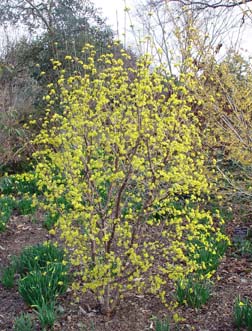 Cornus
mas 'Spring Glow'
Cornus
mas 'Spring Glow'
The next stop was at a fine specimen of Cornelian cherry (Cornus mas 'Spring Glow'), a seedling selected by J. C. Raulston at NC State in 1990 for
its extraordinarily early profusion of gold flowers in March. Mike admired
its attractive dark green and heat tolerant foliage, showing no signs of disease
late into October. Unlike most other Cornus mas, which produce handsome
red fruits in the summer, 'Spring Glow' does not.
Viburnum 'Conoy'
Not tonight, deer! Addressing the common problem of deer eating garden plants,
Mike claimed that although they eat most viburnum, deer will not eat Viburnum 'Conoy'. The parent, Viburnum utile, adds deer resistance. He mentioned
also that both University of Georgia and Tom Ranney are breeding new viburnums
with a goal of producing fragrant flowers.
Illicium lanceolatum
The Chinese anise (Illicium lanceolatum), one of his favorites, has rose-pink
flowers, good evergreen compact mound form, and suffers no drought stress.
Also for textural effects, it could replace Kalmia in southern gardens.
Members of Illicium in the star-anise family are among the last shrubs
deer will eat in the garden. They contain a fragrant substance called safrol,
which gives the anise shrubs (also Sassafras) their fragrance and makes
them less desirable to foraging deer.
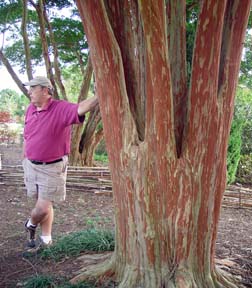 Lagerstroemia
fauriei 'Fantasy'
Lagerstroemia
fauriei 'Fantasy'
He recounted the story of the 'Fantasy' Japanese crepe myrtle (Lagerstroemia
fauriei 'Fantasy'), one of the original seedlings of Lagerstroemia fauriei planted in the U.S. during the 1950s. The seeds were collected by John Creech (U.S. National Arboretum) on Yakushima Island in Japan, where they are endemic.
He told of how Don Egolf, Ph.D., one of the foremost plant breeders of
ornamental woody plants in the U.S., took advantage of its mildew resistance
to breed 20 new cultivars of resistant hybrid crepe myrtles at the U.S. National
Arboretum.
Always ready to share the spotlight and let other people shine, Mike took the opportunity repeatedly to promote others. He ended his afternoon tour by emphasizing how fortunate we are that dedicated plantsmen like Todd Lasseigne, Ph.D., the several southeastern nurserymen present, and plant breeders like Dennis Werner, Ph.D., and Tom Ranney from the NC State faculty, were keeping more exciting new plants coming our way.
Plant More Labels!
By Nancy Doubrava, Interpretive Specialist
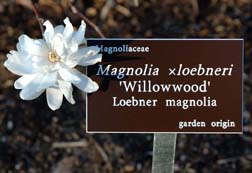 Last
year a survey was conducted in which members of the JC Raulston Arboretum were
asked what could be done to improve their next visit to the Arboretum. One
of the top suggestions was clear - label more plants. Twenty years ago, the
first labeling volunteers, led by Tom Bumgarner, started making
the familiar wooden plant labels for the Arboretum. The new permanent engraved
labels began appearing five years ago, when an engraving machine was purchased
by the newly hired Arboretum director, Bob Lyons, Ph.D. The
project of making permanent labels was handed over to me, Nancy Doubrava,
the new interpretive specialist. With over 6,000 taxa at the Arboretum, this
proved to be a daunting task.
Last
year a survey was conducted in which members of the JC Raulston Arboretum were
asked what could be done to improve their next visit to the Arboretum. One
of the top suggestions was clear - label more plants. Twenty years ago, the
first labeling volunteers, led by Tom Bumgarner, started making
the familiar wooden plant labels for the Arboretum. The new permanent engraved
labels began appearing five years ago, when an engraving machine was purchased
by the newly hired Arboretum director, Bob Lyons, Ph.D. The
project of making permanent labels was handed over to me, Nancy Doubrava,
the new interpretive specialist. With over 6,000 taxa at the Arboretum, this
proved to be a daunting task.
Many things happen behind the scenes before a permanent label reaches the garden. The first step in the process is to input accurate plant identification, origin, and nomenclature. Former assistant director, Todd Lasseigne, Ph.D, has been responsible for completing this task, with the help from past students, including Jon Roethling, research technician. Now that Todd has moved on, we have started to develop a new group to research the names for accuracy. This information is then easily exported from the Arboretum's plant database, thanks to a system created by Valerie Tyson, plant recorder. A dedicated group of volunteers led by Vergean Birkin, then imports the information into standardized models created by Chris Glenn on the engraver's computer. We are also grateful to Chris for troubleshooting the engraving machine's programs and creating new models as needed. Finally, the labeling volunteers, still led by Tom Bumgarner, place the labels in front of the proper plant in the gardens.
To date,
- 2,800 taxa have been researched in preparation for a permanent label;
- The engraving volunteers have made 4,100 engraved labels and given over 1,665 hours of their time;
- There are 3,500 plants in the Arboretum with an engraved label and we are still chipping away at the over 4,600 remaining.
A special thank you goes to NC State's Phi Alpha Xi, Ornamental Horticulture and Floriculture Honor Society, for providing financial support since the project's inception.
So, next time you wonder what plant that is, just look for its label.
Student Project
Tsunami-inspired Project Teaches Far-reaching Lessons
By Nancy Doubrava, Interpretive Specialist, and Anne Spafford, Assistant Professor, NC State
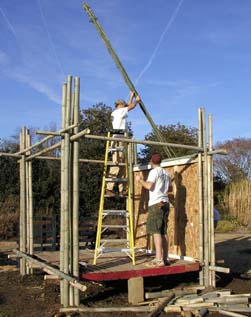 |
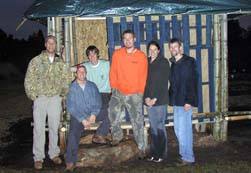 |
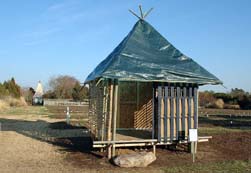 |
Students in Anne Spafford's Landscape Construction Studio (Horticultural Science 495C) were challenged to think globally this semester, as they designed temporary shelters to assist people devastated by the tsunami in Southeast Asia. Their goal was to design and build temporary shelters using inexpensive, or better yet, salvaged and environmentally friendly local building materials.
Students began by researching Southeast Asia in earnest. Details were collected about location, climate, people, typical architecture, local building materials, and construction methodologies. The students were encouraged to reuse packaging materials from the enormous amount of relief aid being shipped in from around the world. With access to fresh water a critical issue, the incorporation of a water catchment system was a requirement of each design.
Students then built study models of possible shelter designs. The best features from several models were selected by the class and incorporated into one final 8' by 8' design. A full size structure was built, and as expected, a lot of redesigning took place on site, depending on what materials were salvaged from around town. A close look at the structure reveals a framework of bamboo (a renewable resource) and flooring made from wooden pallets. The front wall features a sliding wall/door made from pallets, rough-sanded and stained. The other walls demonstrate use of various building materials, including particle board, a bamboo weave, and lattice (okay, okay we bought this as a timesaving measure, but larger pieces of debris would work here too!). The open lattice wall on the south facing side is designed to support an annual vine. The inhabitants of the shelter will remain dry thanks to a roof made of a waterproof plastic tarp (similar to packing material used in shipping dry food goods).
We invite you to visit this shelter, constructed in the northwest corner of the Annuals Trial Area at the JC Raulston Arboretum. It will be on display for the duration of the growing season. The completed project will be documented as drawings and images and sent to aid agencies.
Development
Gala in the Garden
By Donna Walker, Development Associate
What's the best spring party around? Why, of course, the JCRA Gala in the Garden! Well known as the spring social calendar kick-off, this is an event for all friends and supporters of the JCRA. On Sunday, May 1, 2005, the Gala will be held in the garden with cocktails, hors d'oeuvres, live music, and a silent auction featuring a plethora of unique plants and an eclectic array of other distinctive items. The afternoon will culminate with a delicious dessert social and an exciting raffle drawing in the York Auditorium in the Ruby C. McSwain Education Center. We're keeping the admission at the same low $50.00 per person it's been for several years.
We encourage those who wish to participate as corporate sponsors to go to our Web site at <www.ncsu.edu/jcraulstonarboretum> to see the various corporate levels and their benefits. This is the Arboretum's main fund-raising event of the year, with proceeds supporting daily operations of teaching, research, and public garden displays. Please consider a contribution of $1,000.00 and become a special Silver Level Sponsor.
The Gala in the Garden provides a distinctive opportunity to entertain your family, friends, and business associates while strolling around the grounds, perusing all the dazzling auction items. Corporate sponsors are also invited to enjoy the hospitality tent, designed exclusively for use by Gala sponsors and their guests.
Please call Anne Porter at (919) 513-3463 or Donna Walker at (919) 513-3826 with questions or for further information, or go to the Arboretum's Web site and click on Gala.
Gala Container Garden Contest
Here's your chance to help the JCRA with the Gala in the Garden and put your gardening skills to the test all at once. We're having a container garden contest! The gardens will be judged by Arboretum staff and the winner will receive either an engraved brick to be placed in our courtyard or two tickets to Gala 2006 - your choice. We'll use all entries as part of our decorations at Gala 2005 and they will also be included in the auction. Go to our Web site at <www.ncsu.edu/jcraulstonarboretum> for all the details or contact Donna Walker at (919) 513-3826 or <donna_walker@ncsu.edu> for more information about the contest. We'll only need 22 containers so don't wait to contact us!
Planting the Seeds for Development
By Anne Porter, Director of Development
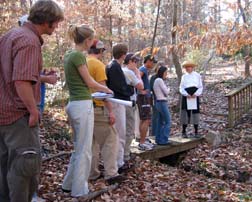 A
Gift of a Garden
A
Gift of a Garden
In the heart of Raleigh and less than ten minutes away from our Arboretum, there is another enchanting place to visit - the Joslin Garden. For more than 50 years, William and Mary Coker Joslin have worked to transform the four acres surrounding their home into gardens containing an extensive collection of plants. Arranged with great sensitivity to cultural conditions, native plants are well represented with both substantial shrub and herbaceous perennial layers. It is a delightful treat for everyone, from the most devoted horticulturist or botanist to the novice gardener to those who just enjoy natural beauty in all its splendor.
A Little History
At the turn of the twentieth century, this land was a farm owned by Bryan
Grimes, then Secretary of State. Remnants of an old dam and the farm's
terraces in the sloping woodland area are still visible. The area surrounding
"Broken Dam" was the site of a Boy Scout camp. The farm was aptly
named "Arrowhead Farm" because of the many arrowheads found throughout
the area. An ancient mortar and pestle was also discovered here, giving further
indication of Native American activity.
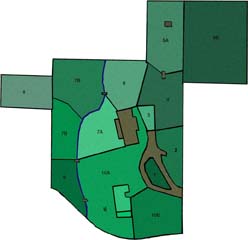 The
Garden
The
Garden
In a hillside setting crisscrossed with natural springs, the Joslin Garden
is designed as a series of garden rooms consisting of naturalistic plantings
and architectural features. The paths are designed to follow, in sequence,
the various themes of the plant collections. The size and maturity of many
specimens serves to make this garden a unique asset to our community.
The garden is a living museum that is a constantly changing organic entity, developing and adjusting to topography, climate, and other environmental factors. Some plants are rare, while others are examples of what we are fast losing: the natural flora of Piedmont North Carolina.
Special Partnerships
The Joslin Garden is a special gift with great significance for the training
of young horticulturists, designers, and botanists. Mary and William Joslin's
desire is to see their garden serve generations of students in the understanding
and appreciation of ecological garden design. NC State's Department of Horticultural
Science professors Pat Lindsey, Ph.D., and Will Hooker have worked
closely with the Joslins to make their dream a reality. Other NCSU partnerships
include the Department of Landscape Architecture and the Department of Botany.
Open GardenApril
2, 2005 (Saturday) - 9:30 AM-6:30 PM Everyone is cordially invited to attend the Joslins' Annual Open Garden Day. |
A Legacy Garden
The Joslins have deeded their garden to NC State, subject to their right
to live on the property and maintain and improve it for their lifetime. They
have also established, with the Triangle Land Conservancy, a perpetual conservation
easement that allows the property to be used for garden and horticultural purposes
only.
Through the Joslins' philanthropy and planned gifts to NC State, this exquisitely detailed and flourishing residential garden will forever be a Raleigh treasure for everyone to enjoy.
Your Legacy
If you would like to learn more about how you might leave a legacy, please call or e-mail Anne Porter at (919) 513-3463 or <anne_porter@ncsu.edu>.
Thanks for Supporting the Annual Appeal and the New Dr. Robert E. Lyons JCRA Internship Endowment!
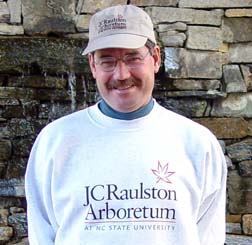 Thanks
to all of our members and friends of the Arboretum who generously supported
the 2004 Annual Appeal.
Thanks
to all of our members and friends of the Arboretum who generously supported
the 2004 Annual Appeal.
A very special thank you to everyone who supported A Legacy for the Future - Dr. Robert E. Lyons Internship Endowment in honor of Bob Lyons.
Serving as director of the JCRA from 1999 to 2004, Bob Lyons' dedication, leadership, support, and service were invaluable to the growth and stability of the Arboretum. The JCRA Board of Advisors set a goal of $50,000.00 in order to fully fund this endowment and create a permanent intern position that will benefit both the Arboretum and worthy students throughout the years. Through the generosity of members and friends of the Arboretum, we will make this goal.
If you would like to be part of this tribute to Bob and part of a lasting legacy to the Arboretum, please contact Anne Porter at (919) 513-3463 or <anne_porter@ncsu.edu> or Donna Walker at (919) 513-3826 or <donna_walker@ncsu.edu>.
Ways to Give Beyond Membership Support
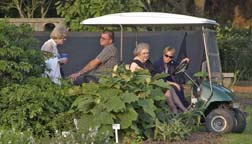 Outright
Gifts
Outright
Gifts
Include cash, appreciated property (stock or real estate), or tangible personal
property.
Matching Gifts
Many gifts from active or retired employees qualify for matching gifts from
their employers. Please check with your employer - this could double your gift!
Bequests and Planned Gifts
You may specify a gift by writing your will or living trust to include the
JC Raulston Arboretum as a beneficiary. A planned gift is an incredible opportunity
to capture tax-saving benefits now and leave a rich legacy for the future.
Memorial Gifts
What better way to remember or honor a loved one, friend, business, or organization
than with a special memorial tribute gift? There are many opportunities - from
an engraved brick, to a garden bench, or a named garden. This is a gift that
keeps on giving!
Real Estate or Securities Gifts
Donors pay no capital gains on the increased value with their gift of stock
or other appreciated real estate.
Gifts of Insurance
You may specify the JC Raulston Arboretum as beneficiary of an existing
policy, or you may make a pledge by purchasing a new whole life insurance policy
and naming the JCRA as the recipient.
For more information on these giving opportunities, please call or e-mail Anne Porter at (919) 513-3463 or <anne_porter@ncsu.edu>.
4th of July Rooftop Celebration!
By Anne Porter, Director of Development
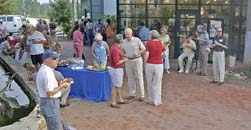 |
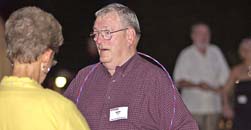 |
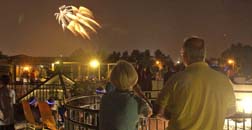 |
July 4, 2005 - The Arboretum will once again be the hot spot for the 4th of July Rooftop Celebration. This event is hosted by Johnny Wynne, Ph.D., Dean of the College of Agriculture and Life Sciences at NC State. This special event recognizes the College's corporate sponsors and major donors.
Want to join in the fun? Here is your chance. We invite you to become a 2005 Gala in the Garden sponsor! For more details click on "Gala" on the Arboretum's Web site at <www.ncsu.edu/jcraulstonarboretum>.
Arboretum Update
Butterfly Garden Renovation
By Judy Morgan-Davis, Interpretive Assistant
Renovation of the Butterfly Garden began last year and is scheduled for completion in April 2005. The new garden will be filled with woody plants and perennials that provide food for butterflies and their larvae, of course; however, the garden is designed to be attractive to a variety of wildlife. Many of the plants included in the design produce fruits or seeds that feed birds as well as butterflies. Although the original amphibian inhabitants of the garden were carefully rescued and relocated, frogs will enliven the new pool in time. This special water feature will also meet the needs of male butterflies that collect salts from damp soil. Keep an eye on the progress as this area metamorphoses into a beautiful garden once more!
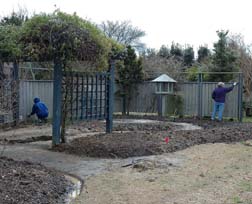 |
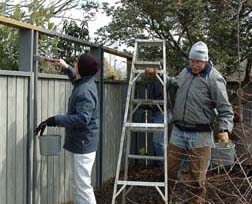 |
Drainage Improvements and the Contemplation Garden
By Christopher Todd Glenn, Programs & Education Coordinator
Even in a relatively dry winter like we had this year, there are still some drainage problems in the Arboretum. Interim Director Kim Powell has begun to correct a few of the most difficult areas, starting with the vicinity near the Perennial Border extension.
Installation work began on the Contemplation Garden shortly after the New Year. Bland Landscaping Co., Inc. was hired to install the hardscaping which should be completed by April 2005.
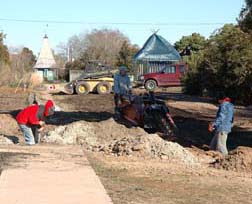 |
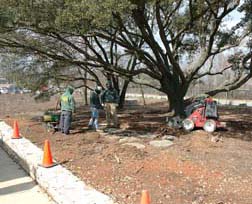 |
Volunteering
Volunteer News
By Frankie Fanelli, Volunteer Coordinator
Volunteer Curators & Coordinators
Susan Andrews - Winter Garden Co-curator
Pam Baggett - Entry Garden Curator
Harvey Bumgardner - Finley-Nottingham Rose Garden Co-curator
Tom Bumgarner - Labeling Curator
Claude & Mary Caldwell - JCRA Archives Co-curators
Dave Duch - Winter Garden Co-curator
Anne Clapp - Finley-Nottingham Rose Garden Co-curator
Bob Davis - Aquatic Gardens Curator
C. J. Dykes - Wisteria Garden and Vines Curator
Wendy Elliot - Butterfly Garden Curator
Frankie Fanelli - Paradise Garden Curator
Barbara Kennedy - Roving Gardening Group Coordinator
Charlie Kidder - Southwest Garden Curator
Amelia Lane - Mixed Border Curator
Mary McClure - Klein-Pringle White Garden Curator
Pat McCracken - Magnolia Collection Curator
Bob Roth - Lath House Curator
Adrienne Roethling - Perennial Borders Curator
Bill Satterwhite - Bluebird Houses Curator
Ann Swallow - Japanese Garden Curator
Dick & Judith Tyler - Winter Garden Co-curators
TBA - Container Gardens Curator
JCRA Volunteer Opportunities
JCRA Book & Gift Shop
Volunteers are needed for the spring season. Hopefully, we will have enough volunteer staffing to have the shop open daily!
Evening Gardening
A gardening team meets every other week from 6:00 PM to 8:00 PM so that the office bound have a chance to get some garden time! The day of the week is yet to be determined.
Weekly Gardening
This gardening opportunity may work with one of the curator teams or with the roving group that works where needed!
Curators
Many new garden areas need curator expertise. These opportunities require strong horticultural talent, the capability to lead a team of gardeners, and an on-going, regular contribution of time.
Special Skills
From time to time we have a need for skills other than horticulture. Several wooden garden structures need repair and painting. The preparation of program announcements can use the expertise of a graphic designer.
Contact Frankie Fanelli about volunteer opportunities at (919) 513-7004 or by e-mail at <frankie_fanelli@ncsu.edu>.
Programs
For more information concerning any of the Arboretum's events, please visit the Arboretum's Web site at <www.ncsu.edu/jcraulstonarboretum> or call (919) 515-3132.
Pi Alpha Xi Annual Spring Plant Sale
April 9, 2005 (Saturday) - 8:00 AM-4:00 PM
April 10, 2005 (Sunday) - 10:00 AM-3:00 PM
JC Raulston Arboretum parking lot
Offering rare and unique annual, perennial, and woody ornamentals. Proceeds
benefit horticultural scholarships and area nonprofit organizations. For more
information, contact a Pi Alpha Xi member at (919) 515-3178 or visit <www.ncsu.edu/project/pialphaxi>.
Friends of the Arboretum Lecture
"Bringing Butterflies into Your Garden"
John Dole, Ph.D., Professor, Department of Horticultural Science, NC State
April 21, 2005 (Thursday) - 7:30 PM
Free for members - $5.00 for nonmembers
York Auditorium, Ruby C. McSwain Education Center, JCRA
Everyone knows and loves the Monarch butterfly but there are so many more beautiful
species you can attract and enjoy in your yard. Learn what it takes to make
a butterfly friendly yard and learn to identify some of the common species you
can find in your yard.
Gala in the Garden
May 1, 2005 (Sunday) - 3:00 PM-7:00 PM
$50.00 - Advanced registration required
JC Raulston Arboretum
Join us for a delightful spring afternoon with cocktails, gourmet hors d'oeuvres,
live music, and a silent auction featuring a plethora of unique plants and an
eclectic array of many other distinctive items.
Meet the JCRA's Curators and Gardeners in Their Gardens
May 14, 2005 (Saturday) - 10:00 AM-12:00 PM
Free
JC Raulston Arboretum
Volunteer curators and gardeners are essential to the Arboretum's daily needs
contributing their time and knowledge. Here's your chance to meet the people
behind the scenes. Volunteers will discuss the gardens and collections as well
as the history behind them. Join us and wander through the Arboretum on this
special day celebrating our volunteer curators and gardeners.
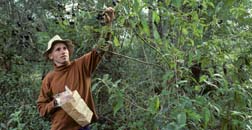 Willie
York Memorial Friends of the Arboretum Lecture
Willie
York Memorial Friends of the Arboretum Lecture
"A Collectors View of Mexico - What I Have Learned in 25 Years!"
Carl Schoenfeld, Yucca Do Nursery, Hempstead, Texas
May 19, 2005 (Thursday) - 7:30 PM
Free for members - $5.00 for nonmembers
York Auditorium, Ruby C. McSwain Education Center, JCRA
A review of what has been learned in 25 years of exploring temperate zones in
Mexico. The talk will begin on the scope and significance of the Mexican flora
and branch out to emphasize specific plant groups and their associated communities
such as pine-oak, woody lilies, bulbs, perennials, and flowering shrubs. Interlaced
in these discussion will be comments on the habitat niches that these plants
occupy and why.
Formatted into HTML by Christopher
Todd Glenn
Programs & Education Coordinator
JC Raulston Arboretum
Department of Horticultural Science
North Carolina State University
Raleigh, NC 27695-7522
© The JC Raulston Arboretum, April 2005


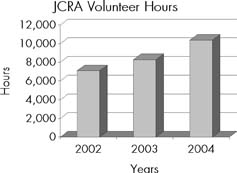 Volunteers
are contributing more of their talents and time than ever before! As
you can see from the chart below, volunteer hours have climbed each of
the last three years. JCRA volunteers not only work hard but enjoy both
social and educational events conducted especially for them. An extra
special benefit is the camaraderie and plant knowledge that volunteers
readily share with each other and the staff. Do take a few minutes and
read about the available volunteer opportunities. Please contact Frankie
Fanelli at (919) 513-7004 or <frankie_fanelli@ncsu.edu> to discuss
the possibilities!
Volunteers
are contributing more of their talents and time than ever before! As
you can see from the chart below, volunteer hours have climbed each of
the last three years. JCRA volunteers not only work hard but enjoy both
social and educational events conducted especially for them. An extra
special benefit is the camaraderie and plant knowledge that volunteers
readily share with each other and the staff. Do take a few minutes and
read about the available volunteer opportunities. Please contact Frankie
Fanelli at (919) 513-7004 or <frankie_fanelli@ncsu.edu> to discuss
the possibilities!